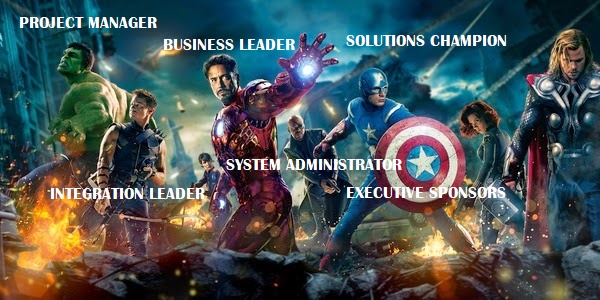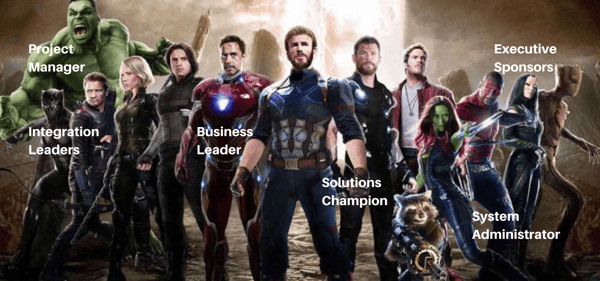Implementing a WMS - The Superhero Team That Will Save You

 These times of chaos are leading us to great changes in our businesses, where it is a case of evolve or perish. Are you embracing e-commerce? Making the move to omnichannel? Finally implementing that warehouse management system?
These times of chaos are leading us to great changes in our businesses, where it is a case of evolve or perish. Are you embracing e-commerce? Making the move to omnichannel? Finally implementing that warehouse management system?
That's great, but now what? Well, not all heroes wear capes - the best ones come with gadgets. And with so many technologies to consider, even superheros are better with a team - trust us, you want them on your side to ensure everything goes smoothly.
The current global landscape is changing and it demands that we do too. To separate yourself from your competitors you need to more than ever before, faster, smoother, and cheaper. And as the old adage goes, if you want to go far, go together.
A warehouse management system (WMS) is a huge investment for your business, and one that will take you to the next level. Once you commit you must get the most out of your system as quickly as possible, not only because of the costs and time invested throughout the selection, implementation and daily operational processes, but to ensure you are giving customers the ultimate service, yesterday.
Like with any massive project (including the Avengers, the Justice league, and more!) the best way to ensure that your changes and implementation starts with a bang is to have the right team of specialist heroes in place from the very start, each proficient in their own sphere.

Building your WMS implementation team. Roles & skills you need for success
The best car in the entire world won't go anywhere without a driver. Likewise, an incredible system can’t deliver optimum results without the support of a strong, skilled, dedicated and passionate team. So now that you've chosen your ideal WMS, you need to ensure you have the best team in place to ensure success and meet your business case objectives. Especially if it is world domination... Move over, Bezos.

The essential team you need to successfully implement a WMS to enjoy its full benefits include:
- Executive Sponsors (CIO, COO, VP/Director of Operations and VP/Director of Logistics)
- Project Manager
- Business Leader(s)
- Solution Champion
- Integration Leader
- Database/System Administrator
- Hardware Leader
- Warehouse Manager (when applicable for the solution being implemented)
- Change Management Leader
1. Executive Sponsors (CIO, COO, VP/Director of Operations and VP/Director of Logistics)

Your Executive Sponsors should provide executive leadership and strategic vision to the team.
Like the firm, cerebral leader of the X-Men, the Executive Sponsors need to define, monitor and approve attainment of project goals and objectives.
Their role includes approving “executive level” WMS implementation schedules, as well as reviewing and approving the preparedness of the team as well as post-project assessments. Additionally their scope extends to reviewing and approving budgets, project scope and timeline changes. Yes, their insights should feel like they are plugged in to every element of the business!
2. Project Manager

Your project manager is king of the WMS implementation process.
Project managers are the glue that holds your team together, giving them the support they need to keep the implementation running smoothly while communicating with the Executive Sponsors.
Project managers are like Black Panther - keen strategists, agile, and a pivotal part of any WMS implementation project. They have some key roles, including managing the implementation issues list, resolving business issues, liasing with the WMS provider and proactively monitoring all the responsibilities of all the players.
Your project managers need to be adept juggling many responsibilities:
- Identify, define and prioritising implementation issues
- Assign accountability
- Communicating issues to all appropriate parties
- Drive issues to closure as well as resolving business issues related to budgeting, licensing, invoice reconciliation/payment, maintenance, scope management and timelines
That’s just the tip of the iceberg - they also need to proactively monitor the team’s responsibilities to ensure the appropriate involvement of operations throughout the project.
Want to see what world class warehouse efficiency looks like in action?
Download the Tarsus Distribution case study to see how Tarsus (in partnership with Supply Chain Junction) used Manhattan SCALE to increase their warehouse efficiency by 60%.
3. Business Leaders

Business leaders are important headline figures in WMS implementation.
They need to communicate business requirements, sign off on business process design, ensure business data validation and provide leadership during training and go-live.
They also play a key role in assisting with change management with the rest of the team: team members must be able to look to leaders within the business, and follow their lead in adopting new technology.
While not all business leaders can look like Thor, at least they can all channel his command!
4. Solution Champion

Solution champions take their cues from Flash to be lightning fast and on the ball.
Their role includes testing programs as soon they’re delivered, engaging in feedback, serving as the day-to-day point of contact for all warehouse management system implementation-related issues, as well as lead unit, system and volume testing.
5. Integration Leader

Just like Batman, an integration leader needs to be highly observant and have a nose for technologies.
His strength lies in staying ahead of the curve of constant development, and advising the team how to maximise these offerings.
They are key to the integration process and need to:
- develop and/or test interface programs between host system(s) and their WMS
- develop and test required conversion programs
- plan and execute a strategy to keep systems synchronised
6. Database/ System Administrator

System administrators are a protective force field for your WMS.
Detail-oriented, deadline-driven, and organised, they are like The Invisible Woman, the behind-the-scenes magic you need for successful WMS implementation. Of course we chose a woman to be doing the hard work!
They manage software installation and project preparation, identify appropriate media, load software, establish remote access, assign passwords with proper authority, among many other key administrative functions.
7. Hardware Leader

Hardware leaders are your tech geniuses, with some pivotal tasks that have a big impact on the WMS implementation project.
They need to:
- complete system sizing documents, incorporating growth projections
- determine corporate system architecture and networking communications strategy
- assist with facility preparation; implementing all peripheral hardware, including configuration of workstation IDs.
Tony Stark might have wanted to play alone, but these people certainly don't. They are essential for making this a friendly transition for everyone.
8. Warehouse Manager

Just like Star-Lord, warehouse managers are tech savvy, adaptable and have advanced problem-solving skills.
They need to represent the operations group throughout the project, participate during functional and detail design to validate that system configuration decisions meet operational needs, develop standard operating procedures, and confirm facility and warehouse preparedness during the Preparedness Assessment, among many other key roles.
9. Change Management Leader

As the person responsible for coordinating the changes, the person responsible for change management guides the process by setting a great example.
This is a vital role in the WMS implementation process and it should be managed and run by a training and change professional
- preferably not someone from IT or HR.
Training and change is a specialised skill that requires accreditation and experienced resourcing. The training and change function should run in parallel with the vendor project to ensure alignment of vision and mission on the project.
In conclusion:
Any chain is only as strong as its weakest link - conversely, it can be as strong as the foundation you lay.
Your ultimate business success relies on a well-optimised warehouse, which in turn requires a great team as outlined above, who need to have a set of processes and in place that will assist a joint collaboration to optimise your warehouse. With the developments in digital offerings and the move of customers in a Covid world onto more virtual platforms, you need a solution that is flexible, scalable, and comprehensive.
Remember: your warehouse and its ability to successfully execute orders is the key to delighting your customers, each and every time. And happy customers are what superheroes are all about!
How much does it cost, and how much benefit can you gain from the full WMS implementation process?
Download the ROI Guide here and establish how your investment will change your business.
TAGS
- WMS (50)
- Warehouse Best Practice (46)
- Implementing a WMS (29)
- Managing your warehouse (19)
- Omni Channel (18)
- eCommerce (18)
- Blog (16)
- Supply Chain Best Practice (16)
- Mid-Level (8)
- Customer Journey (7)
- Warehouse optimisation (7)
- General Tips (5)
- Industry General (5)
- Information (5)
- managing your Supply Chain (5)
- saudi arabia (5)
- Trends (4)
- smart warehouse (4)
- 3PL (3)
- News (3)
- ERP (2)
- Entry-level (2)
- ROI (2)
- Case Study (1)
- OMS (1)
- Picking (1)
- Press Release (1)
- Solution-Specific (1)
- Transport Management System (1)
Take A Look At The Results Of A Successful WMS Implementation.
See how Tarsus Distribution, in collaboration with SCJ boost overall efficiency by 60%







